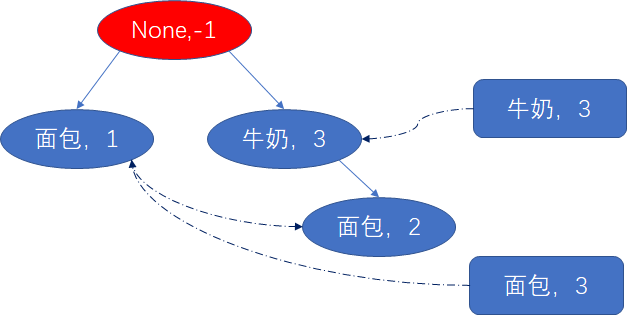关联规则挖掘之FPGrowth算法实现
1 关联规则挖掘之FPGrowth算法实现
Apriori算法通过利用频繁集的两个特性,过滤了很多无效集合,提高了算法效率。但是算法每一次对频繁项集的筛选都需要扫描一次原始数据集,对于大规模数据集Apriori的算法效率不尽如人意。
FPGrowth算法由韩家炜[1]等人于2004年提出,其中FPTree是使得这一算法相比Apriori等算法较为高效的关键数据结构,FPTree将数据库中的所有事务(Transactions)高度压缩成树的路径,所有的频繁项(Frequent Items, FIs)都成为树的一个节点,每个节点都拥有相应的计数,代表该FIs在数据库中出现的次数,其中叶子节点的计数等于前向遍历路径中的FIs出现在数据库中的次数。因此所有的挖掘工作都以最初的FPTree为中心展开,而在构建一棵FPTree时,核心步骤在于对每一条事务进行降序排序。
1.1 FPTree的构建
- 树结构设计
def __init__(self,idName,count=1):
"""构造函数
Args: Type Meaning
idName String 编号
count int 计数
next FpNode 下一个id号相同的结点
parent FpNode 父结点
children List[FpNode]孩子结点
"""
self.idName = idName #根结点为None
self.count = count #根结点为-1
self.next = None
self.parent = None
self.children = []
-
算例演示
同样我们以在关联规则挖掘之Apriori算法实现中的购物篮数据集为例演示FPTree的构造,频繁项的绝对支持度设置为3。
TID Items T1 {牛奶,面包,1} T2 {面包,尿布,啤酒,鸡蛋,1} T3 {牛奶,尿布,啤酒,可乐,1} T4 {面包,牛奶,尿布,啤酒,1} T5 {面包,牛奶,尿布,可乐,1}
表中每一条记录中的数字表示记录出现的次数,如T1,{牛奶,面包,1}中的1表示同时购买牛奶,面包的记录出现了1次。
-
Step1:第一次扫描原始数据集,得到所有满足最小支持度阈值的频繁1项集,并按照项的计数降序排列;
Item Count(desending) 牛奶 4 面包 4 尿布 4 啤酒 3 -
Step2:第二次扫描原始数据集,删除每条数据中的非频繁1项集,并按照计数降序排列每条数据中的项;
注意:这里降序排列时,一定要保证项的相对顺序,如这里选择了频繁1项集的排序为牛奶、面包、尿布、啤酒,那么数据集中的每一条数据(这里已经去除了非频繁1项集)都应该按照频繁1项集中项的相对顺序排列。
构建FPTree,初始时,新建一个标记为None的空节点。按顺序扫描记录,将记录中项添加到FPTree中。
- 第1条记录:{牛奶,面包,1}降序排列够得到{牛奶,面包,1},新建一个结点,idName为**“牛奶”,将其插入到根节点下,并设置count为记录中的数字即1,然后新建一个“面包”结点,插入到“牛奶”**结点下面。插入后如下所示:

同时,为了便于候选在FPTree上挖掘频繁项集,我们构建了一个线索表,线索表中元素由频繁1项集按照计数降序排列组成。随着FPTree的构建,将同idName的结点地址相连。如示例中的线索表为{牛奶:[牛奶结点地址],面包:[面包结点地址],尿布:[尿布结点地址],啤酒:[啤酒结点地址]}。
- 第2条记录:{面包,尿布,啤酒,鸡蛋,1},删除非频繁1项集再降序后得到:{面包,尿布,啤酒,1}。访问FPTree的根结点None,发现其子结点没有包含面包,因此新建一个面包结点,将其作为根节点None的第2个子结点,随后新建尿布结点上接新建面包结点,下接新建啤酒结点,并根据新建结点更新线索表,新建结点的计数均为所在记录的计数。
- 第3条记录:{牛奶,尿布,啤酒,可乐,1},删除非频繁1项集再降序后得到:{牛奶,尿布,啤酒,1}。访问FPTree的根结点None,发现其子结点上含有牛奶结点,则将牛奶结点的计数+新记录中的计数(这里为1);接着访问牛奶结点的子结点,发现牛奶结点的子结点中无尿布结点,因此新建尿布结点,上接已有牛奶结点,下接新建啤酒结点,并根据新建结点更新线索表,新建结点的计数均为所在记录的计数。

- 第4条记录:{面包,牛奶,尿布,啤酒,1},删除非频繁1项集再降序后得到{牛奶,面包,尿布,啤酒}。访问FPTree的根结点None,发现其子结点上含有牛奶结点,则牛奶结点计数+当前记录的计数;继续访问牛奶结点的子结点,子结点中含有面包结点,同样将面包结点计数+当前记录的计数;继续访问面包结点的子结点,发现子结点中并无尿布结点,因此新建尿布结点上接面包结点,下接新建啤酒结点,并根据新建结点更新线索表;同样,新建结点的计数均为所在记录的计数。
-
第5条记录:{面包,牛奶,尿布,可乐,1},删除非频繁1项集再降序后得到:{牛奶,面包,尿布,1}。访问FPTree的根结点,发现其子结点上包含牛奶结点,将牛奶结点计数+当前记录的计数;继续访问牛奶结点的子结点,包含面包结点,则将面包结点计数+当前记录的计数;继续访问面包结点的子结点,包含尿布结点,将尿布结点的计数+当前记录的计数。
1.2 利用FPTree挖掘频繁项集
频繁项集的挖掘从线索表表头的最后一项开始,依次从后往前挖掘,如此例中,线索表的表头为[牛奶,面包,尿布,啤酒],那么挖掘顺序为啤酒 → \rightarrow →尿布 → \rightarrow →面包 → \rightarrow →牛奶。挖掘流程如下:
-
此例中从啤酒开始,根据啤酒的线索链找到所有包含啤酒的结点,然后找出每个包含啤酒结点的分支:
{牛奶,面包,尿布,啤酒,1},{牛奶,尿布,啤酒,1},{面包,尿布,啤酒,1},其中的1表示分支出现的次数为1次,由分支中啤酒的计数决定。除去分支中的啤酒,得到新的数据记录{牛奶,面包,尿布,1},{牛奶,尿布,1},{面包,尿布,1}。然后按照FPTree的构建方式构建啤酒的条件FPTree。
- 啤酒分支对应的数据集
TID Items T1 {牛奶,面包,尿布,1} T2 {牛奶,尿布,1} T3 {面包,尿布,1} - 啤酒的条件FPTree
构造好条件树后,对条件树进行递归挖掘,递归的终止条件为当前条件树只有一条路径,此时路径的所有组合即为条件频繁集。如当前啤酒的条件频繁集为{{},尿布},于是啤酒的频繁集为{{啤酒},{尿布,啤酒}}
-
接下来找线索表表头的倒数第2项尿布的频繁集,同理可以得到尿布的前缀路径为:{面包,1},{牛奶,1},{牛奶,面包,2}
- 尿布分支对应的数据集
TID Items T1 {面包,1} T2 {牛奶,1} T3 {牛奶,面包,2} - 尿布对应的条件FPTree
由于当前条件树中存在两条路径,因此进行递归挖掘。从尿布线索表表头的最后一项即面包项开始进行挖掘。同理面包的前缀路径为,{牛奶,2}
-
面包分支对应的数据集
TID Items T2 {牛奶,2}
由于当前数据集不满足最小绝对支持度的要求,因此面包的条件FP树为None,满足条件FPTree的路径数仅有一条的条件,因此当前面包的条件频繁项集为{},面包的频繁集为{面包}。
同理尿布线索表表头的剩余项牛奶的频繁集为{牛奶}
最终:尿布的频繁集为{{尿布},{牛奶,尿布},{面包,尿布}}(**注意:**尿布自身也是频繁集)
重复以上步骤,对线索表中的每个项进行挖掘,即可得到整个频繁项集。
1.3 参考
[1] Han jia wei, Pei Jan等 Mining Frequent Patterns without Candidate Generation: A Frequent-Pattern Tree Approach.2004.
[2] https://www.cnblogs.com/fengfenggirl/p/associate_fpgowth.html.
1.4 代码实现
-
树结点的设计
class FpNode: def __init__(self,idName,count=1): """构造函数 Args: Type Meaning idName String 编号 count int 计数 next FpNode 下一个id号相同的结点 parent FpNode 父结点 children List[FpNode]孩子结点 """ self.idName = idName #根结点为None self.count = count #根结点为-1 self.next = None self.parent = None self.children = [] def addChild(self,child): """添加一个孩子结点 Args: Type child FpNode """ self.children.append(child) def addCount(self,count=1): self.count += count def setNextNode(self,next): """设置下一个结点 Args: Type next FpNode """ self.next = next def setParent(self,parent): """设置父结点 Args: Type parent FpNode """ self.parent = parent def getChild(self,index): """指定索引取孩子 Args: Type index int """ return self.children[index] def hasChild(self,idName): """查找是否包含id为idName的孩子 Args: Type idName string """ for i in range(len(self.children)): if self.children[i].idName == idName: return i return -1 def __repe__(self): return "id: " + self.idName + "count: " + str(self.count) \ + "孩子个数" + str(len(self.children)) -
FPTree的构建
from FpNode import FpNode class FpTree: def __init__(self,dataSets,min_num): self.dataSets = dataSets #待挖掘数据集,[[...,count],[...,count],...] # self.min_num = round(min_support * FpTree.countnum(dataSets)) #最小支持数=最小支持度*数据量 self.min_num = min_num def scan1(self): """构建项头表,也就是按照频次降序的频繁1项集 Returns: L1 频繁1项集{1项集:计数} """ L1 = {} #频繁1项集 for record in self.dataSets: for item in record[:-1]: if item in L1.keys(): L1[item] += record[-1] else: L1[item] = record[-1] delrecord = [] #记录不满足支持度的项,非频繁项 for item,count in L1.items(): if count < self.min_num: delrecord.append(item) if delrecord: for item in delrecord: del L1[item] L1List = sorted(L1.items(),key=lambda x:x[1],reverse=True) L1.clear() for item in L1List: L1[item[0]] = item[1] return L1 def scan2(self,L1): """删除样本数据集中的非频繁1项集,并按照频繁1项集的计数排序 Args: L1 频繁1项集{1项集:计数} Returns record 删除非频繁1项集后的数据 """ record = [] for row in self.dataSets: newrow = [] for key in L1.keys(): #频繁1项集 if key in row[:-1]: newrow.append(key) if newrow: newrow.append(row[-1]) #加上计数 record.append(newrow) return record def createFpTree(self,L1,Ls): """构建Fp树 Args: L1 频繁1项集 Ls 去除非频繁1项集后的记录 Returns: headerTable 线索表 root Fp树根 """ nodeLinkTable = {idName:FpNode(idName,num) for idName,num in L1.items()} #线索表 headerTable = nodeLinkTable.copy() root = FpNode(None,-1) for L in Ls: currentRoot = root #根结点 for idName in L[:-1]: index = currentRoot.hasChild(idName) #当前结点是否在当前根结点的子结点中 if index >= 0: currentNode = currentRoot.getChild(index) #是,则取出 currentNode.addCount(L[-1]) #结点出现次数加上当前记录的重复次数 else: #否,则新建结点 currentNode = FpNode(idName,L[-1]) currentNode.parent = currentRoot currentRoot.addChild(currentNode) nodeLinkTable[idName].setNextNode(currentNode) #记录同idName的项 nodeLinkTable[idName] = currentNode currentRoot = currentNode return headerTable,root @staticmethod def levelOrderTraversal(root): """层序遍历,检测Fp树是否构建完整""" record = [] #记录每一层的idName Q = [root] while Q: currentNode = Q.pop(0) record.append(currentNode.idName) Q.extend(currentNode.children) return record -
频繁项集的挖掘
from FpTree import FpTree def conditionFpTree(leafNode): """生成指定项的条件树 Args: headerTable 线索表头 root Fp树根 leafNode 指定项 """ ###首先找到所有包含指定项的分支,并以指定项截断### newLs = [] #包含指定项的所有分支记录,以指定项截断 while leafNode: currentNode = leafNode L = [] Flag = True #标注是否与当前结点相连的仅有根结点 while currentNode.parent and currentNode.parent.idName != None: L.append(currentNode.parent.idName) currentNode = currentNode.parent Flag = False if not Flag: L.append(leafNode.count) newLs.append(L) leafNode = leafNode.next ###其次计算新的频繁1项集和去除非频繁项后的所有分支记录### ft = FpTree(newLs,3) #创建新树实例 newL1 = ft.scan1() #新的频繁1项集 newLs = ft.scan2(newL1) #去除非频繁项后的分支记录 ###最后构建指定项的条件树### newheaderTable,newroot = ft.createFpTree(newL1,newLs) return newheaderTable,newroot #层次遍历树,当只有一个叶结点时,表明条件树只有一条路径 def isSingleLeaf(root): """层序遍历 Args: root 根结点 Returns: bool 树是否有分支 """ record = [] #记录每一层的idName Q = [root] while Q: currentNode = Q.pop(0) record.append(currentNode.idName) Q.extend(currentNode.children) return len(record) <= 2 #[None]或者[None,item] def frequent(condTreeItems): """生成仅有一条路径的condTree上的所有频繁项集 Args: condTreeItems 条件模式基[item1,item2,....] Returns: fks 频繁项集 """ fks = [[]] for item in condTreeItems: fks += [items + [item] for items in fks] return fks def miningFrequentSet(leafNode): """递归挖掘指定项的频繁集 Args: Type leafNode FpNode Returns: """ frequentSet = [] currentHeaderTable,currentRoot = conditionFpTree(leafNode) if currentHeaderTable == dict(): frequentSet.append([leafNode.idName]) return frequentSet if isSingleLeaf(currentRoot): #判断条件树是否是单树 if currentRoot.children: condTreeItems = [] currentNode = currentRoot.children[0] while currentNode: condTreeItems.append(currentNode.idName) if currentNode.children: currentNode = currentNode.children[0] else: break frequentSet = frequent(condTreeItems) if frequentSet: for s in frequentSet: s.append(leafNode.idName) else: frequentSet.append([leafNode.idName]) return frequentSet else: targetIdName = leafNode.idName leafNodeIdNames = list(currentHeaderTable.keys()) leafNodeIdNames.reverse() for leafNodeIdName in leafNodeIdNames: leafNode = currentHeaderTable[leafNodeIdName] currentFrequenSet = miningFrequentSet(leafNode) currentFrequenSet = [subset + [targetIdName] for subset in currentFrequenSet] #以指定频繁项结尾 frequentSet.extend(currentFrequenSet) frequentSet.append([targetIdName]) #加上自己 return frequentSet def loadDatas(testdata=1): if testdata==1: dataSets = [['牛奶','面包',1], ['面包','尿布','啤酒',1], ['牛奶','尿布','啤酒',1], ['牛奶','面包','尿布','啤酒',1], ['牛奶','面包','尿布',1] ] else: dataSets = [['A','C','E','B','F',1],\ ['A','C','G',1],\ ['E',1],\ ['A','C','E','G','D',1],\ ['A','C','E','G',1],\ ['E',1],\ ['A','C','E','B','F',1],\ ['A','C','D',1],\ ['A','C','E','G',1],\ ['A','C','E','G',1]] return dataSets # L1 = {'牛奶':4,'面包':4,'尿布':4,'啤酒':3} def main(): dataSets = loadDatas(1) ft = FpTree(dataSets,3) L1 = ft.scan1() Ls = ft.scan2(L1) # print(L1) # print(Ls) headerTable,root = ft.createFpTree(L1,Ls) #创建Fp树 currentHeaderTable,currentRoot = headerTable,root nodeIdNames = list(currentHeaderTable.keys()) nodeIdNames.reverse()#倒序,即按照项出现次数升序排列,先挖掘出现次数少的 # print(nodeIdNames) for idName in nodeIdNames: leafNode = currentHeaderTable[idName].next print(miningFrequentSet(leafNode),end='\n') if __name__ == "__main__": main()




